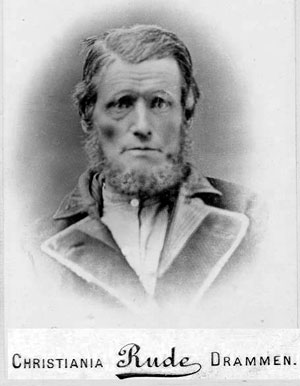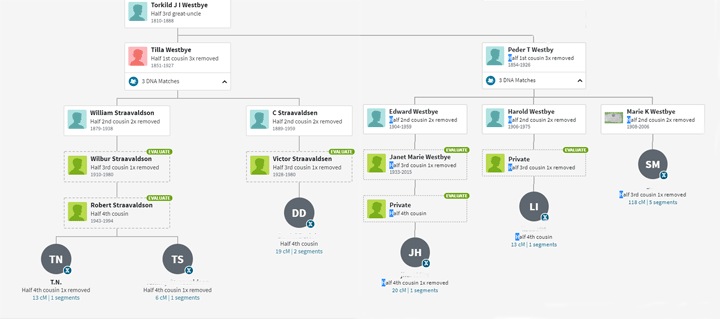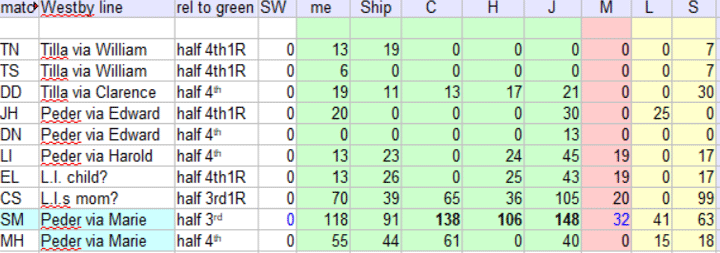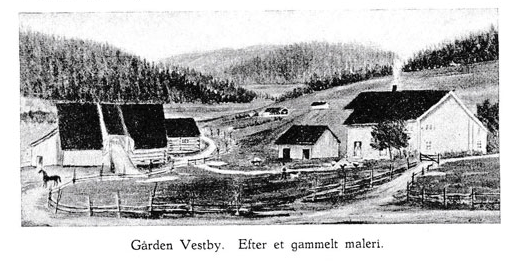My great great grandfather Jørgen Oleson Wold, 1816-1892, from Skougar near Drammen, Norway, was born 9 years before his parents tied the knot. Although his father is listed as the man his mother eventually married, DNA testing has stirred up my doubts.

Having a child out of wedlock was not uncommon in rural Norway of the 1800s. It was not considered shameful in many areas. Often the couple would marry later on; you had to be able to support a wife in order to have one. Another reason is that people wanted to be sure they could have children before marrying, since many hands were needed on the farm. The data shows that quite often women were pregnant at the altar. Click here for an article showing that having a sexual relationship and getting pregnant was the normal way to start a marriage in at least one area of Norway at that time. Night visiting, fully clothed, was a customary way for young people to get to know each other.
According to the 19th century clerygyman and sociologist Eilert Sundt (my 10th cousin 3R), who looked carefully at many population statistics, 43% of all Norwegian children were conceived before their parents got married back in the mid 1800s. Click here for the article that cites this.
The problem for Jørgen’s parentage is that there are no DNA matches on just his father of record’s line. It is always possible to get less DNA from one 3rd grandparent but it seemed that all my family’s matches to the descendants of other children of that marriage were smaller than expected. We also have many matches quite far back on Jørgen’s wife’s line, suggesting it was possible we just had more DNA from her side but also demonstrating that when there are many generations of large families, DNA matches to 5th and 6th cousins will be found. This is also true on our other Norwegian lines.
Could Jørgen have a different father? If so, I would expect to see a group of 4th cousin matches who match each other but are not assigned to any of our known lines. Since Norwegian records are good, our ancestors are well documented back into the 1700s or even earlier.
There is a large group of matches that fits that scenario, all descended from one Torkild Westby b 1810, Drammen, Norway. It so happens that Westby/Vestby is a farm in Skoger just outside of Drammen where Jørgen may have lived as a youth. Norwegians did not have surnames back then, they used their father’s name plus their farm of residence which could change. Also W was pronounced as V in Norway so they are interchangable in the spelling. When Torkild’s children came to America they used the surname Westbye. I found the birth record for Torkild in the Norwegian archives and sure enough, he was born on farm Westby in Skoger..

Torkild’s birth and baptism record in the Skoger Churchbook for 1810 – http://urn.digitalarkivet.no/URN:NBN:no-a1450-kb20070402610138.jpg (3rd from bottom on right)
I decided to try a ThruLines experiment by changing Jørgen’s father to Torkild’s father, Jahn Jahnsen Westbye, in my Ancestry tree and see what happened. For Jørgen’s father and grandfather of record, Thrulines listed no DNA matches that were not also listed for his son.
Within a day, ThruLines showed 6 matches on myThruLines list for Jahn Jahnsen Westby, all descending from Torkild. Plus there are many more common matches in the Westby cluster group without trees. My brother and Wold side cousins all had new ThruLines matches as well.
Another possibility is that Jørgen’s listed father, Ole Christensen, might be the biological father of Torkhild. However when I compared a known 4th cousin from the Christensen group, those descended from Jørgen’s parents of record, to all these Westby people there were no matches to any of them. Since most of those cousins tested elsewhere, now I need to convince some of these Ancestry matches to upload to GEDmatch where there are more Wolds and Christensens than at Ancestry to check if any others match the Westby group.
In the diagram below, the Westby descendants are listed on the left by initials and the amount they share with the various descendants of Jorgen are in the columns. Note that “SW”is a (half) 4th cousin descended from Jorgen’s parents of record. The people shaded green are all in my generation descended from Jorgen via his daughter Maren. Yellow is one generation below me, also from Maren, and M, the reddish columns is one generation above me from Jorgen’s son Charlie. M seems to have far less DNA from Jorgen as she shares only 11 cM with her half 3rd 1R “other” as well as less with these Westby relatives.
A third option is that my great grandmother Maren had Torkild for a father, not Jorgen, This seems to fit the DNA shared with the Westby group but not the small matches to the Christensen group. Then M’s matches to the Westbys would have to be from a further back ancestor. Note that both Torkhild and Jorgen were living on South Imjelt farm in Skoger in the mid 1800s. Torkel owned it and Jorgen worked as the overseer. The birth certificates of Jorgen and Anna’s first six children including Maren, all list the farm South Imjelt as the place of birth.
At this point I am somewhat convinced of my theory that Jørgen and Torkel share a father but need to do more research and look at more tests before I change my trees everywhere.
Here are my action items:
- Get more of the Westbye matches to upload to GEDmatch so I can compare them to my father and other Wold descendants that tested at different companie and confirm they do not match other Christensens, descendants of Jørgen’s parents of record.
- Use the What Are the Odds Tool at DNApainter (WATO) to try out the different theories
- See if I can find a male line Christensen descendant. Find out if he also has the viking I1 Y-haplogroup that the Wold line has. If so, then get him and my male Wold cousin to do Y 37 tests at Family Tree DNA,
- See if I can find a male line Westbye descendant and find out if he also has the viking I1 Y-haplogroup. If so, then get him and my male Wold cousin to do Y 37 tests at Family Tree DNA,
- Look through the records for Skoger to learn more about my new ancestors. Thanks to my cousins in Svelvik, Vestfold, (descended from a brother of Jørgen’s wife Anna) I now have copies of the farmbook pages for Vestby/Westby and Imjelt and I am slowly transcribing it all to GENI although I have not yet changed Jørgen’s father to Jahn Jahnsen Westbye. I need more proof.
- Find other descendants of Jahn Jahnsen Westbye not descended from Torkild and see if they have DNA tested yet …
Stay tuned!



The surname Westby rings a bell! Lots of cousins to check out. However, at this point I am not aware of matches from the Drammen area.
This is an interesting one to me; my grandfather was illegitimate, I’d love to find his father (my paternal “real” surname). I have a candidate through family legend, surname Campbell. Problem is, I have loads of autosomal matches on all of my father’s branches with this surname; it’s really popular in Argyll, Scotland. I did a Y-DNA (67) test, top matches all surname MacPherson; the closest GD however is 2.
I’ve created clusters of DNA matches from Ancestry but can’t tie up the loose ends.
Scott –
The key to this type of research is to get as many of his descendants to test as possible, and older generations whereever possible.
Plus build a deep tree for all the other lines, back to at least 1800. use the Ancestry color coding to group all the known lines as per this post:
https://blog.kittycooper.com/2019/07/using-the-new-ancestry-dna-match-features/
and see if there is a group left over like there was in my case
Ignore family legend for now and go with the DNA. Surname MacPherson is quite likely but further back adoptions can always cloud the issue
I really like how you explain your process as you conduct the research. In your comment above you said to test as many descendants as possible. I’m dealing with a nearly impossible only son of only son (of 3 he was the only one who had a child) of only son. This is my paternal Gould line and been a brick wall for over 16 years. Y testing of my brother 12 years ago hasn’t helped at all. I will never give up trying to find the parents of my 2nd great grandfather, but it’s a very difficult journey.
I’m trying to understand this. I’m 43 and recently found out I don’t know who my father is. I uploaded my dna from ancestry to gedmatch and got a series of emails from someone regarding endpoints and crossovers and I’m sure he did his best to explain but I am still lost. I tried to manipulate the thru lines to figure out so things but it didn’t work because I don’t know what I am doing. I have a match that logically can only be a half niece. Her father is not interested in finding out (he also doesn’t know who his dad is and his mother is deceased. Mine is unable to produce any info.) So here I am. I share nearly twice the cM with this half niece that I share with my brothers kid from my mom’s side. So it’s very confusing. I have many 2-3rd cousins, all from similar surname. I made a tree and can figure a certain line that I can match them to but I’m unsure if that will help me. I’m afraid to reach out to much although some of them have been very kind. I mean I don’t want to upset anyone’s life. I just want to know who I come from. Any advice?
Stephanie –
Hugs. This is difficult information to process for many. Hope you are doing OK with it. I will email you privately as well.
The methodology used by adoptees works even better for one unknown parent see
https://blog.kittycooper.com/more-dna/help-for-adoptees/
One more thing Stephanie, it may help to build a private tree which is searchable where you put a fake father in for yourself, child of your possible grandparents if you have that figured out. Then attach your DNA to a child of that fake father
This post describes the pedigree triangulation process
https://blog.kittycooper.com/2020/04/when-the-found-father-needs-help-understanding-the-dna-results/
you and I are in the same situation. My daddy was born of a non-legal marriage. The man married Grandma for her dowry. we are not sure the name on the marriage lisence is correct. nobody with that last name has shown up on DNA yet. how do you suggest I proceed. BTW i also have my brothers DNA
Do a Y DNA test 37 or 67 marker test for your brother at family tree DNA. They often have sales around father’s day. That will often turn up a surname in the match list for Y. Here is my affiliate link: https://affiliate.familytreedna.com/idevaffiliate.php?id=1529_0_3_5
Also use automated clustering to look for clusters that do not correspone to your known family lines. Good to build those other lines back to at least 1800 to help with this. See my clustering posts: https://blog.kittycooper.com/tag/dna-clustering/
I have a similar problem, but working with Danish names. The closest testers
I have to work with are FTDNA tests uploaded to my Heritage. Sadly no Ancestry ones.
There are no male descendants on my line from the mystery man.
re. action 4. I was unaware that Ancestry offers any Y-DNA testing.
You can determine the high level Y haplogroup from the Ancestry Raw DNA results see https://blog.kittycooper.com/2019/06/why-y/
Hello, Kitty!
Thanks for sharing!
This bit “I am slowly transcribing it all to GENI” got me curious. What is you approach to that transcribing?
I’m asking because I’ve got a bunch of records with people living in a village where my grandfather was born. Many share surnames with my known ancestors. I haven’t got proof how exactly they are related, but there certain clusters of related people, so I was wondering if it was good idea to put them on Geni as unrelated trees until I find connections to my main tree.
Best regards,
Roman
Great idea.
I use an online OCR program and then google translate to add snippets from the books see http://blog.kittycooper.com/2014/04/translating-farm-books-using-a-norwegian-ocr-program/
I’m helping the family of a friend research their adopted mother’s ancestors. This particular post is timely because it looks like a similar “try-before-you-buy” marital arrangement may have occurred in the mid-1800s in Tennessee. The marriage records show this couple didn’t marry until 1880, but the genealogy shows that they parented children as early as 1855. The affected surnames include Dillon, Sweat, and Ledbetter – don’t know if there’s any Norwegian heritage there. But are you aware of this type of arrangement in mid-1800s Tennessee? I’m a little skeptical given the popularity of camp revivals there at that time.
No I am not aware of that but I have worked on many unknown parentage cases in TN and far too often the father of record in other trees is wrong. I am working on one now where the mother of the adoptee was also out of wedlock and more wrong fathers were found among her matches!
an example case here
https://blog.kittycooper.com/2017/12/dna-makes-a-merry-christmas/
What part of TN? My mother’s family was in the Smith/Macon Co area since 1800. Could it be a different couple with the same names?
Very interesting! I have absolutely no DNA matches to an identifiable sibling of my 3rd great-grandfather. I have lots of DNA matches to his wife’s purported family (I cannot find a paper trail to her purported father, Isaac Wilkes) but match descendants of just about every one of Isaac’s known children, so I’m sure I’m on the right track there. I just find it really odd that I cannot find anything on “grandpa.” I had my brother do a 37-marker Y-DNA but match only two other Leonard men; one I know how he is related through our common 2nd great-grandfather. The other man does not answer his email. Three additional men match at zero mutation but they each have a different surname than Leonard, and from each other. Not sure exactly what is going on other than a suspected NPE? I recently paid to upgrade my brother’s test to 111-markes and am waiting on the results.
What a genius use of ThruLines! My great-grandmother Jane was born out of wedlock and her mother Adaline did not disclose the identify of the father. Autosomal DNA at FamilyTree and MyHeritage found several users who matched on the same chromosome with me (triangulation!) but it was just a guess that they were related to the unidentified father. I traced them back using conventional methods and they were all related to one or the other of a married couple who lived in Macon County, North Carolina, which is where my ancestors lived. I considered all of the male children and grandchildren and one in particular seemed to be the best candidate due to his age, residence, and military service. When I added him and his parents to my tree at Ancestry.com, back came 23 (!) ThruLines matches, including three descended from my candidate. This isn’t proof of course, but it looks like a strong indicator. I’d been looking for people who would agree to test, and here I had a bunch of them at hand already!
I’ll be re-reading this a few times to see if I can improve on my own approach. After Y-dna testing showed an unexpected result I determined by testing multiple individuals that it’s likely my grandfather’s biological father was not his legal father. That was emphasized when my own dna matches included individuals from every branch of my family except my surname branch (and it’s associated feeder lines), and particularly when one of my closest non-immediate-family matches was born with the surname of a 1870s neighbor. When I set up a hypothetical tree using that woman’s g-gf as my own, ThruLines came up with several dozen dna matches to descendants of that surname. Because I am dealing with a rural Nova Scotian community many of those matches are connected through different paths but the overwhelming number have no known connection. The issue now is to pin it down further with additional testing – unfortunately, as the only son of the only son for several generations, a Y test of other males is unlikely. And that closest match died recently. In any case you have validated my general approach.
Wallace you could try looking further back for a Y descendant of that line as Y changes so slowly.
I did a similar Thru-Lines experiment – making me and my three siblings one generation older to see if I could generate 7C matches (I did). I changed us all right back. I posted this on Facebook / GGTT and you’d have thought I was robbing a bank. For every “good idea” there were 10 scolds who were very afraid that some DNA match would come away with incorrect information in that 24 hour period.
So I’ve extended my Thru-Lines hacks – but now I don’t post it on Facebook : ) And if I add a speculative parent, I label it as such. Thru-Lines can be a great tool….
Kitty,
Thanks for the very interesting post. I have a somewhat unrelated question about Scandinavian dna research. I am trying to find my mother’s grandfather’s family in Southern Sweden. My mother was adopted, and so family records or knowledge is non-existent and I have exhausted the paper trail. I have no leads on location or names other than his name. I am using dna matches to try and identify common ancestors. The method of finding the MRCA through surnames does not work well with patronymics. Genetic Affairs Auto-trees comes back with false matches. Any suggestions of how to go about this process, what kinds of spreadsheets to create and what dna research methods are most productive in Sweden. I have my dna in all the major companies and am trying to learn every tool and method I can to break through this long-time brick wall.
Thank you,
Lloya Hall
My research is in Norway, not Sweden, where the farm name is like a surname as long as the family stayed on that farm!
Be sure you have her DNA at all the companies, you may have more luck with MyHeritage or 23andme where there are more Scandinavians.
My advice is build trees for the closest matches yourself. Use GENI.com where there is an extensive Scandinavian presence; since there is just one profile for each person as it is a collaborative tree much of the trees of the best matches may already be there.
Try various facebook pages for Swedish genealogy to get help
FTDNA has for a long time been ”the DNA company” in Sweden, but the others are catching up. As Kitty says, testing your mother and having her everywhere, or if not possible, you say you have yourself everywhere – but do you have siblings to test? And far from all of us are at Geni. How much info do you have on the family? The records in Sweden are mostly excellent. And I’m from Southern Sweden, so I know some are more scarce – and less people have tested here, than in other parts of Sweden. I do agree on joining the facebook groups, there is an open group, very knowledgeable people, Swedish American Genealogy. PS. I agree on the applause for your post Kitty, it’s a very good post!
Thank you Kitty and Eva. Good ideas from both of you. y mother is deceased however I have tested all of my siblings and 5 maternal cousins. There are a few more who won’t test. I have all of the dna tests in the major places and yes, there are the most Swedish matches in FTDNA. My ggrandfather is Peter Lundberg, born about 1849. A newspaper article on his death mentions he was from Southern Sweden. Our family have been searching the paper trail for many years. I have used Arkivdigital and haven’t been able to find a good candidate. I think dna may be the only hope at the moment. I will pursue building out matches trees and try to make the link and check out Geni. Thank you for your suggestions.
Just considering something similar. While verifying my traditional paper research by checking for Dna matches on each of my lines I realised I had no matches for the paternal side of one my great grandfathers. He was no 7 out of 11 children and the younger of twins. The truely surprising part I had to get my head around is that the older twin did have matches with descendants on her paternal side. I know it to be a biological possibility but still not something I expected to see in 1896. Turns out instead I carry dna of the family that my great grandmothers older brother married into. A great granddaughter of my suspect ‘new’ great great grandfather shares 141 cm with my mum which according to the painter seems to put them in play to be half 2nd cousins as I had calculated. All the siblings of both families are married at the time, and my great grandmother’s oldest daughter is only 10 so no one is attempting to conceal an illegitimate child that I can tell. Can you think of any other explanation? many thanks kerry
Wow Kerry, yes that is biologically possible. Lay out a plan like I did to test this hypothesis … your current conclusions seem logical
Thanks for sharing this research Kitty…looking forward to the next instalment!
I would love to use this technique to find the father of my great-grandfather. His mother was an unwed mother in the 1850s and I have no clue who his father is. His mother’s family was 100% Irish. The only group of Irish I have that are not provably related to his mother are two interconnected pileup groups on Family Tree DNA. I have over 400 matches in these two groups in the 2nd-4th cousin range while I have around 200 matches to my mother, just to give you an idea of the crazy size of this group. I’m stumped.
I should note that these matches in these pileup regions mostly have in in the 18-30cm range of largest segment. Also, none of these pile-up matches have any ancestors in their tree in common with any of the others, not that a lot of them have a decent tree to begin with.
Matt – As always, you will have to build their trees yourself to figure this out. That may be difficult as there are special problems with Irish. Have you asked Maurice Gleason for help?
I have ancestors from Vestby in Norway 🙂 Perhaps we are cousins!
Hi Fawn, Have you DNA tested? I am still looking for a male with the WESTBY(E) surname to test… W is pronounced like V in Norwegian by the way …
I am looking for Bowden’s in Australia – do you have any ?
vbgarton@gmail.com